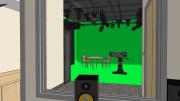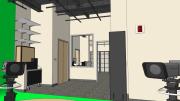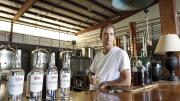A state-of-the art video-capture studio will make its debut in Widener Library this fall, equipped with green screens and 4K capability—the highest resolution format available—to serve as both a high-tech production facility and a “training ground” for faculty members seeking to integrate technology into their teaching, according to University officials.
Located just one floor below a rare Gutenberg Bible, the studio (formally, the Rita E. and Gustave M. Hauser Digital Teaching & Learning Studio, in honor of the couple’s $40-million gift in support of learning and teaching) is designed to enable filming of on-camera lectures, learning modules, and classroom demonstrations in a professional studio environment.
At a time of rising interest in new forms of teaching that may enhance learning (see “Derek Bok on Technology and Teaching,” and also “Reinventing the Classroom” from this magazine’s September-October 2012 issue), technology like green screens allows faculty members to transport students to imagined locations (“green screen” refers to a technique that make people appear to be somewhere they aren’t). For example, senior instructor in computer science David Malan, who teaches CS50/CS50x, “Introduction to Computer Science,” uses the technology to “stand” next to screen shots of programming demonstrations. The team developing the HarvardX course SW12x, “China,” used the same technique to contrast scenes from ancient and modern China.
Officials say they expect the studio (which boasts high ceilings and nearly soundproof walls) to bring together campus experts—including the staff members advancing the Bok Center’s Media Literacy and Visualization Program—and to provide a way for faculty members to learn from one another by getting a behind-the-scenes look at video experiments in process.
“While driven in part by increased interest in online learning, video offers faculty a much broader palette for teaching,” Samantha Earp, the interim executive director of HarvardX, who will serve as a co-manager of the studio, said in a press release. “We made a deliberate choice at HarvardX to do more than back-of-the-room lecture capture. We want to redefine how video can be used in learning, whether capturing a conversation or using artifacts like books. We want to give faculty more ways to tell and share their stories.”










